How to Promote Self-Advocacy in ABA Therapy
March 3, 2025
Empowering Voices: Building Self-Advocacy in ABA Therapy

Understanding Self-Advocacy in ABA Therapy
Self-advocacy is a pivotal skill for individuals with autism undergoing Applied Behavior Analysis (ABA) therapy. It involves teaching these individuals to articulate their needs, make informed decisions, and understand their rights and responsibilities. This skillset is crucial for enhancing independence, confidence, and overall quality of life. This comprehensive guide delves into effective strategies and roles of parents, educators, and therapists in fostering self-advocacy within ABA therapy.
The Importance of Self-Advocacy Skills in ABA Therapy
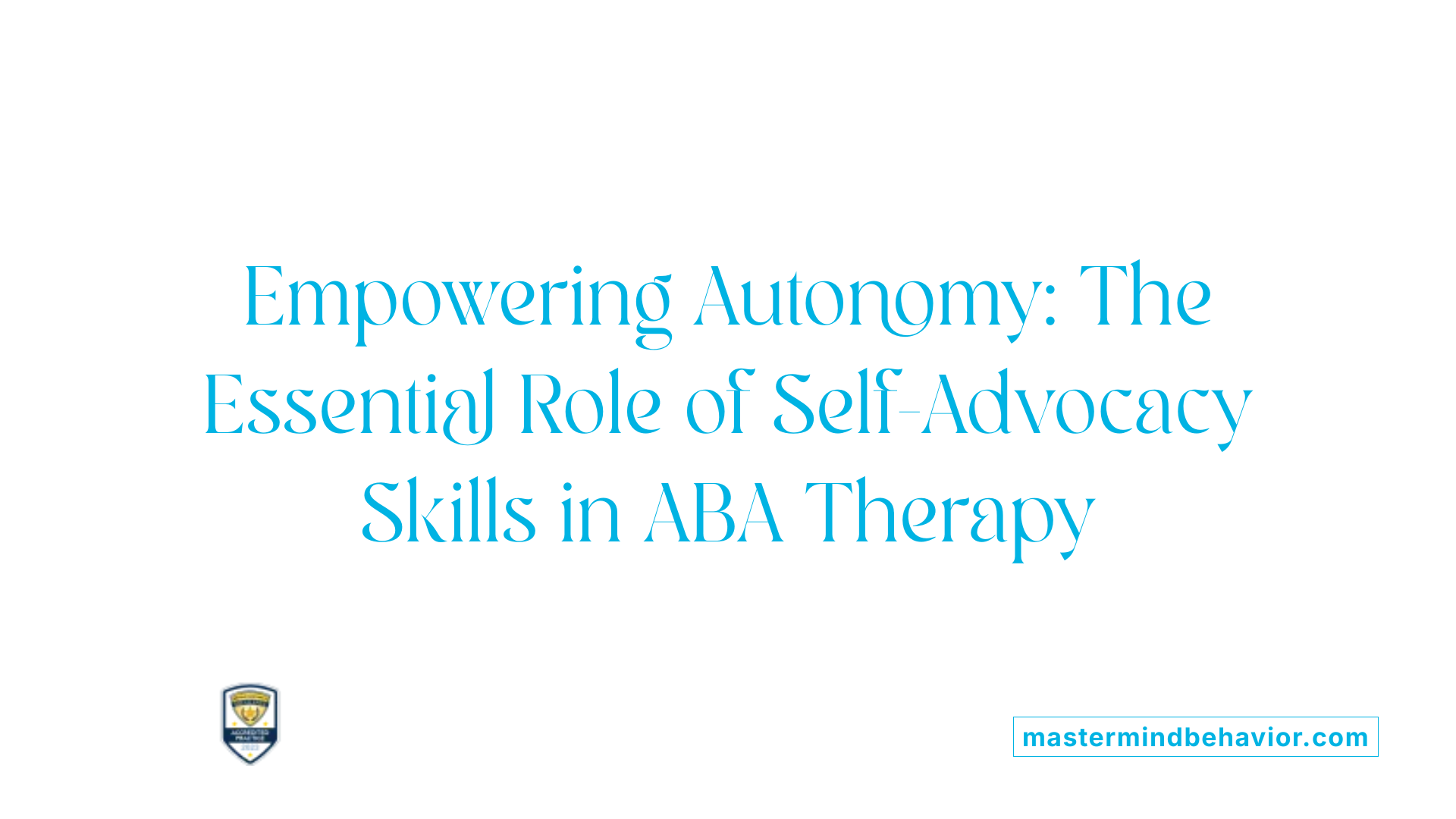
Significance of Self-Advocacy
Self-advocacy is essential for individuals with autism, as it empowers them to articulate their needs and preferences effectively. Starting early in life, teaching self-advocacy skills fosters independence and helps children navigate social settings with confidence. This skill entails understanding personal rights, expressing individual needs, and setting boundaries, which are crucial for avoiding exploitation and promoting autonomy.
Benefits for Individuals with Autism
The benefits of developing self-advocacy skills are abundant. Enhanced communication capabilities lead to increased confidence, better decision-making, and improved inclusion in social and educational environments. In practice, children who advocate for themselves are more likely to request necessary accommodations, engage meaningfully with peers, and cultivate healthier relationships. Research shows that individuals equipped with self-advocacy skills transition more smoothly into adulthood, where they can effectively manage personal and professional challenges.
Integration in ABA Therapy
Applied Behavior Analysis (ABA) therapy plays a pivotal role in instilling self-advocacy skills through structured methods. Techniques such as role-playing, Functional Communication Training (FCT), and positive reinforcement are utilized to enhance verbal and non-verbal communication. For instance, children engage in role-play scenarios where they practice negotiating for needs, like requesting accommodations in school settings. Involving parents and educators in this process not only reinforces the skills learned in therapy but also cultivates a supportive environment for further self-advocacy development. By integrating self-advocacy into ABA therapy, individuals with autism can achieve greater independence and a higher quality of life.
Additional Insights
| Aspect | Details | Outcome |
|---|---|---|
| Significance of Self-Advocacy | Enhances autonomy and expression of needs | Improved communication and independence |
| Benefits | Greater confidence, better decision making | Enhanced participation in social and educational contexts |
| ABA Integration | Role-playing, FCT, positive reinforcement techniques | Real-world practice and increased advocacy skills |
By focusing on the development of these key competencies, we prepare individuals with autism for successful interactions in all areas of life.
Tailoring Self-Advocacy Training to Individual Needs
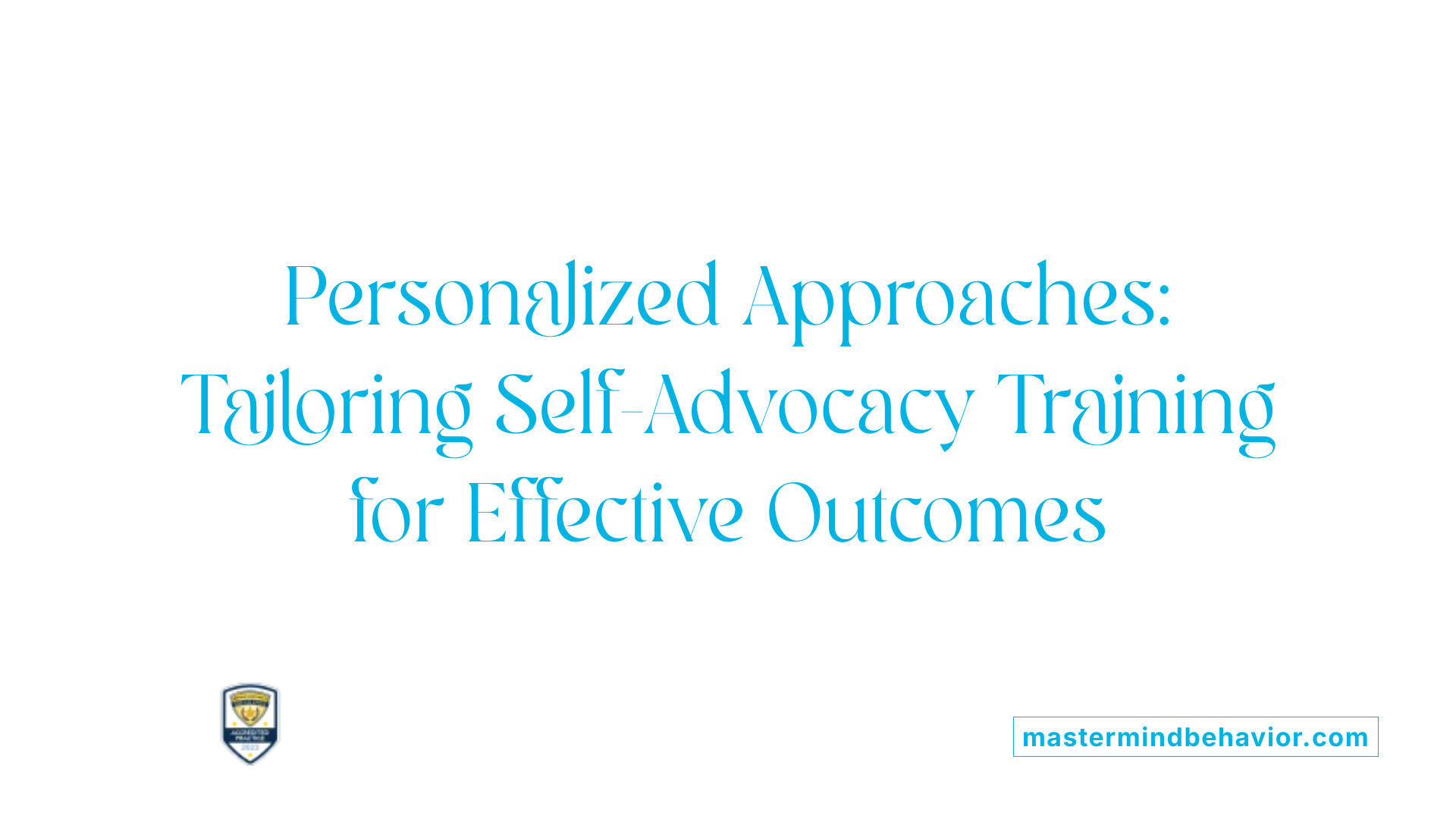
How can we teach self-advocacy skills to individuals with autism?
Teaching self-advocacy skills to individuals with autism involves a multi-faceted approach tailored to each child’s unique abilities and challenges. It starts with equipping them with appropriate communication tools. This can be achieved through communication skills training, where individuals learn to express their needs and preferences effectively. Techniques like using visual supports, such as schedules and social stories, can clarify concepts, making it easier for children with varying levels of verbal communication skills to advocate for themselves.
Incorporating customized instruction is essential to meet the diverse needs of these children. This includes methods such as role-playing where children can practice articulating their needs in real-life scenarios, which reinforces their ability to negotiate effectively. For example, a child might practice asking for adjustments in noisy settings by role-playing situations where they express their discomfort.
The role of Individualized Education Programs (IEPs) cannot be overlooked as they provide a structured environment to foster self-advocacy. Engaging children in IEP meetings allows them to understand their rights and supports, empowering them to communicate their strengths and areas where they require assistance. This active participation not only boosts their confidence but also enhances their self-awareness, which is crucial for independent decision-making.
Overall, a collaborative environment involving parents, teachers, and therapists is vital in nurturing self-advocacy skills. By addressing individual needs and utilizing supportive methods, we can significantly enhance a child's ability to advocate for themselves.
Role-Playing and Real-World Scenarios in Therapy
Practical Application in ABA
Role-playing is a powerful technique used in Applied Behavior Analysis (ABA) therapy to build self-advocacy skills among children with autism. This method allows children to practice responding to different situations in a safe and guided environment. By simulating real-life interactions, therapists can help children develop the necessary communication and negotiation skills to express their needs effectively.
Role-Playing Techniques
During role-play exercises, therapists can introduce various scenarios that children may encounter daily. For example, practicing how to request a quieter environment can empower children to articulate their preferences. Techniques include using scripts, cue cards, or visuals to guide the conversation and ensure children understand their objectives in each scenario, which reinforces their learning and boosts their confidence.
Real-Life Scenario Practice
Implementing role-playing in everyday contexts enhances the learning experience by preparing children for actual situations. This practical application helps children transition smoothly from therapy to real-world interactions, enabling them to assert their needs and establish boundaries in social and educational settings. Parents can reinforce these skills at home by engaging with children in similar role-play practices, further solidifying their self-advocacy capabilities.
Building Independence Through Choice and Autonomy
Encouraging Decision Making
Encouraging decision making in children with autism begins at an early age. Providing opportunities for them to choose between options—like selecting meals or activities—fosters their ability to express preferences. This practice, known as 'forced choice,' gradually builds their confidence in making decisions.
Fostering Autonomy
Fostering autonomy is crucial for developing the self-advocacy skills of autistic individuals. When children are allowed to navigate their choices, they grow more independent and assertive across various environments. Practical methods include using visual supports and checklists to help them articulate their preferences and understand their options.
Developing Self-Awareness
Self-awareness is the foundation for effective self-advocacy. It involves recognizing one’s strengths and challenges, essential for understanding personal needs and aspirations. Activities such as reflection and goal-setting can help children articulate what brings them happiness and fulfillment, which in turn empowers them to communicate their needs more effectively.
| Skill Area | Strategies | Benefits |
|---|---|---|
| Decision Making | Offer choices; practice 'forced choice' | Builds confidence and comfort with decisions |
| Fostering Autonomy | Encourage participation in daily activities | Enhances independence and self-reliance |
| Developing Self-Awareness | Engage in goal-setting and self-reflection | Promotes personal growth and identity knowledge |
Practicing self-advocacy through these targeted strategies not only supports their present needs but also sets the groundwork for future interactions and self-determination.
Parental Involvement in Developing Self-Advocacy
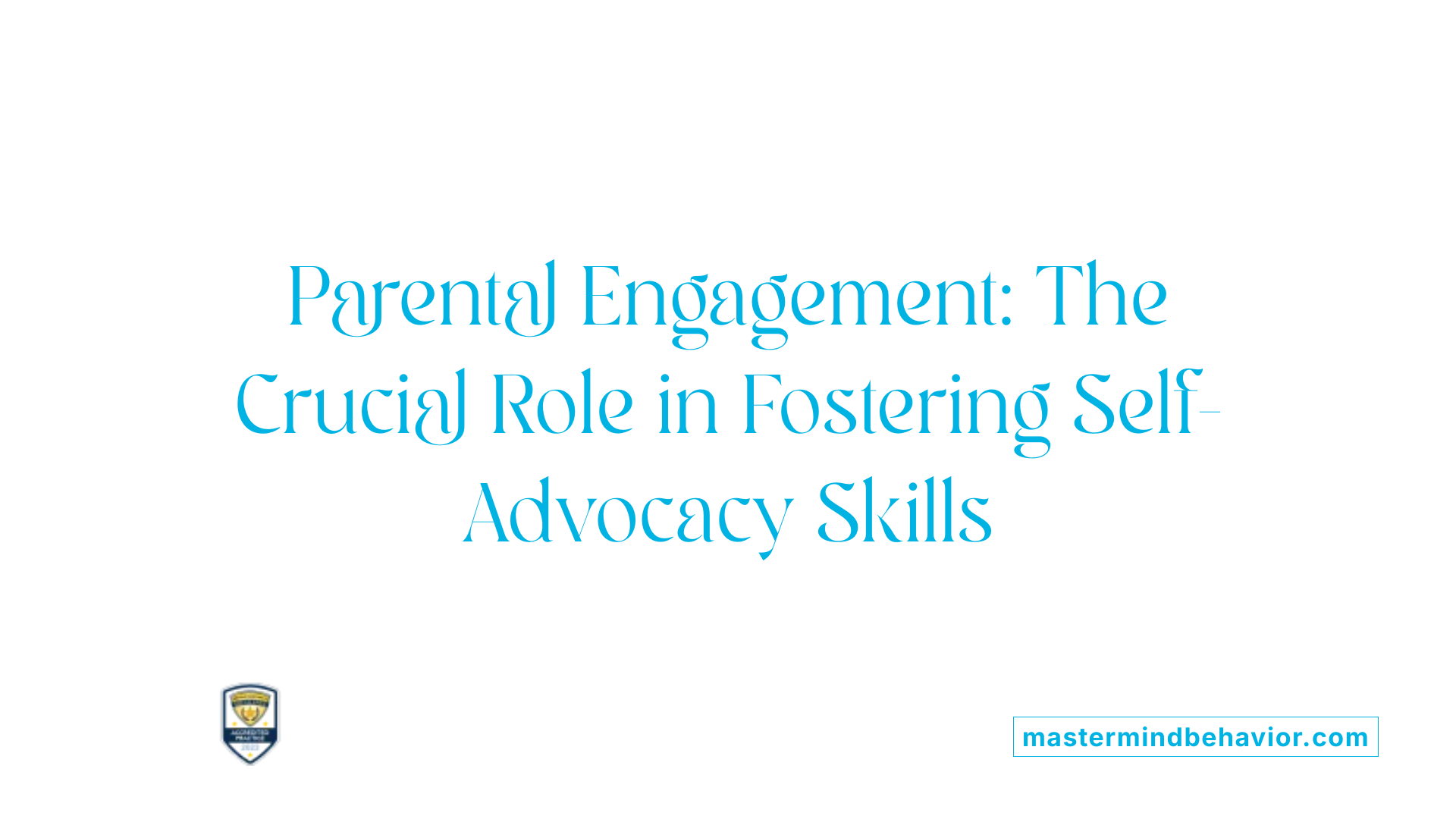
Modeling Self-Advocacy
Parents play a fundamental role in teaching self-advocacy skills to their children with autism. By modeling self-advocacy in daily situations, they demonstrate effective communication, decision-making, and the importance of expressing personal needs. When parents exhibit behaviors such as requesting accommodations or articulating their preferences, they set an example for their children to follow.
Parental Roles and Strategies
Engaging actively in processes like the Individualized Education Program (IEP) meetings boosts children’s confidence and helps them learn about their rights. Parents should encourage their children to make choices, starting with small decisions, which fosters independence. Utilizing practical methods such as social stories and role-playing allows families to practice advocacy skills in supportive settings.
Creating Supportive Home Environments
Creating a nurturing home environment is crucial for self-advocacy development. Parents can offer consistent encouragement and validate their child's feelings, reinforcing that their needs and choices are important. By ensuring children feel safe to express themselves without fear of repercussions, parents enhance their child's ability to advocate effectively.
The Educator's Role in Promoting Self-Advocacy
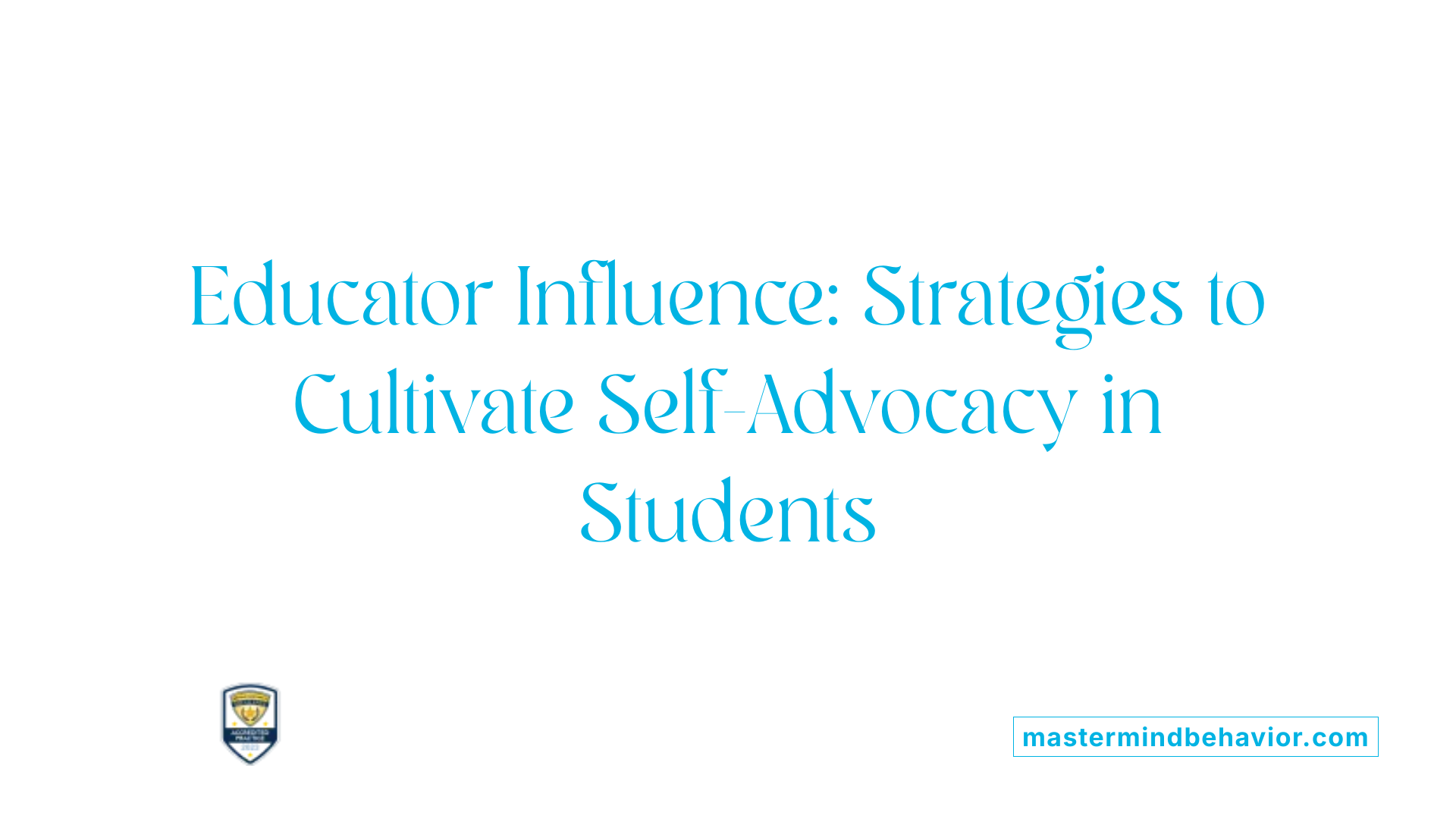
How can educators promote self-advocacy among their students, including those with autism?
Educators play a crucial role in promoting self-advocacy among their students, including those on the autism spectrum. To create an environment conducive to self-advocacy, educators can focus on the following strategies:
Encouraging Self-Reflection: Teaching students about metacognition can help them recognize their own strengths and weaknesses. This understanding allows them to articulate their needs better.
Providing Communication Strategies: Educators should equip students with tools to express their thoughts and concerns clearly. This can include teaching effective communication techniques, such as using "I" statements and role-playing scenarios for practice.
Resource Facilitation: Creating a supportive classroom environment involves facilitating access to resources. This can include study groups, mentorship programs, or allowing anonymous questions—providing a space where students feel safe to express their needs.
Modeling Growth Mindset: Educators should model a growth mindset by framing challenges as opportunities for learning. This encourages students to take risks and view self-advocacy as a skill that develops over time.
Building a Community: Fostering a classroom community that values each student's voice can significantly enhance their self-advocacy skills. Engaging students in discussions about classroom norms and expectations empowers them to take ownership of their learning experiences.
By implementing these strategies, educators can significantly influence their students’ ability to advocate for themselves effectively, building the crucial skills they need for success both inside and outside the classroom.
Therapist’s Role: Instilling Confidence and Self-Advocacy
What are some strategies to support a client’s self-advocacy in therapy sessions?
To support a client’s self-advocacy in therapy sessions, it is crucial to implement clear and understandable information that empowers their understanding of situations. Encouraging their active participation in decision-making is key, as it fosters their confidence and advocacy skills.
Listening carefully and validating client opinions reinforces their value during discussions, ensuring they feel heard and respected. Allowing sufficient time for clients to process information cultivates their ability to articulate thoughts and make informed choices. This patient approach is vital, especially for individuals with varying communication skills.
Therapists also serve as role models for self-advocacy behaviors. By demonstrating positive advocacy techniques, including clear expression of needs and respectful negotiation, therapists guide their clients in effective interactions. Through these supportive strategies, a foundation of confidence in self-advocacy is established, crucial for navigating various environments.
The Importance of Patient Communication Partners
In therapy, having a patient communication partner is fundamental. This fosters an environment where individuals can express their needs and preferences at their own pace, ensuring that their unique communication styles are respected.
Therapists should focus on creating safe spaces that empower clients to explore their thoughts and feelings freely. Encouraging exploration of language, whether through verbal means or alternative communication methods, allows individuals to develop strong self-expression skills.
Listening and Observation Techniques
Therapists are trained to listen and observe the communicative behaviors of their clients carefully. This includes recognizing non-verbal cues and understanding nuances in their interactions. By doing so, therapists can better tailor their strategies to meet individual needs.
Using techniques such as Functional Communication Training (FCT) can enhance understanding of these cues while promoting advocacy skills. Such methods empower clients to navigate social situations more effectively, enhancing their overall autonomy and confidence.
Understanding Self-Advocacy Rights and Legal Support
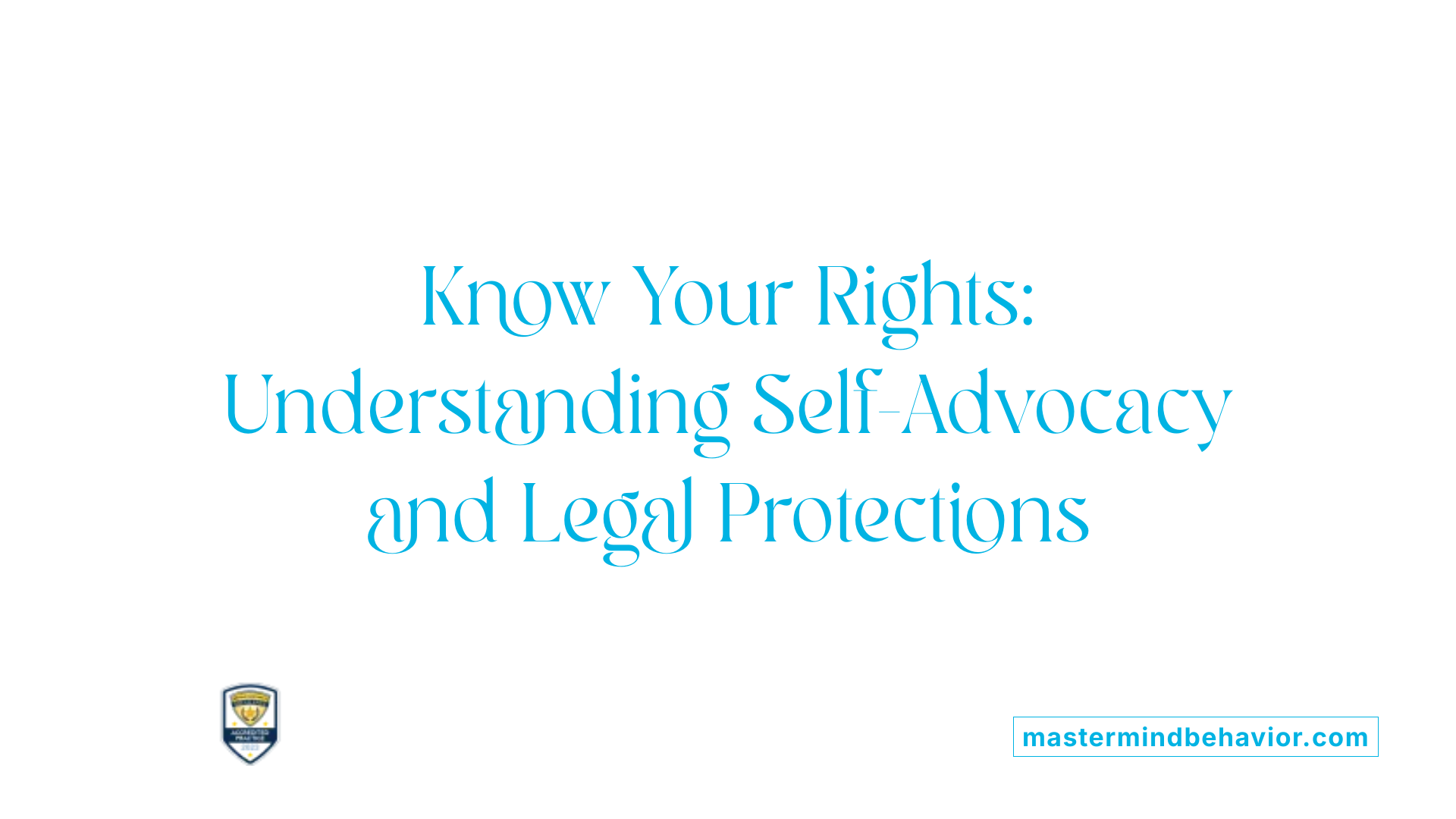
What is the Americans with Disabilities Act (ADA)?
The Americans with Disabilities Act (ADA) offers critical legal protections for individuals with disabilities, including autism. This landmark legislation mandates equal access to public spaces, work environments, and educational institutions. The ADA ensures that individuals can request reasonable accommodations to help manage their disability effectively. Familiarity with the ADA empowers autistic individuals to advocate for their needs confidently.
What are the legal supports for accommodations?
Legal supports for accommodations vary across federal and state levels. Under the ADA, individuals have the right to request modifications or adjustments in their work environment and academic settings to ensure equal opportunity. For instance, a student may need extended time on tests or a quieter exam room due to sensory sensitivities. These accommodations help foster an inclusive environment where autistic individuals can thrive.
Why is it important to know one’s rights?
Understanding one’s rights is essential for self-advocacy. Knowledge of the ADA and associated rights enables autistic individuals to assert themselves when facing discrimination or insufficient support. It fosters self-awareness, allowing them to identify personal needs within the framework of legal protections. By knowing what accommodations are available, individuals can advocate effectively for their preferences, enhancing their overall independence and confidence.
| Rights & Laws | Description | Importance in Self-Advocacy |
|---|---|---|
| Americans with Disabilities Act (ADA) | Protects individuals with disabilities from discrimination and ensuring accommodations. | Empowers individuals to request necessary adjustments responsibly. |
| Individual Education Plan (IEP) | Legal document detailing educational accommodations and services for disabled students. | Encourages participation and awareness of rights in education. |
| Section 504 of the Rehabilitation Act | Ensures accessibility and supports in schools and workplaces for individuals with disabilities. | Supports negotiation and effective self-advocacy in various contexts. |
Research-Backed Insights on Self-Advocacy Development
Benefits of ABA Therapy
Applied Behavior Analysis (ABA) therapy offers a structured approach to promoting self-advocacy skills in individuals with autism. By focusing on effective communication, problem-solving, and social skills, ABA therapy empowers individuals to articulate their needs and assert their rights. The targeted strategies, such as role-playing and visual supports, facilitate practice in self-advocacy, enhancing confidence and independence throughout their daily lives.
Research Findings
Research indicates significant improvements in self-advocacy among children who undergo ABA therapy. For instance, studies have shown that children not only develop verbal communication skills but also engage more effectively in social situations. Effective use of techniques such as Functional Communication Training (FCT) has positively influenced children's ability to initiate conversation and seek accommodations, showcasing the role of therapy in fostering self-advocacy capabilities.
Real-Life Improvements in Self-Advocacy
Parents and educators report that children participating in ABA therapy demonstrate enhanced decision-making skills. Real-world applications, such as requesting support during school or managing personal relationships, reveal a marked increase in confidence. For example, a child who previously struggled with self-expression transitioned into actively participating in group discussions, highlighting the impact of structured interventions. These developments illustrate the profound effect ABA therapy can have on cultivating self-advocacy, equipping children with the tools they need for future challenges.
Conclusion: Bridging the Gap to Independence
Why is self-advocacy important for individuals with autism?
Self-advocacy empowers individuals with autism to express their needs effectively, allowing them to navigate various life situations. This skill is critical in promoting independence and enhancing decision-making capabilities. Moreover, self-advocacy supports autonomy, helping autistic individuals establish boundaries and communicate their rights in educational and social settings.
How can self-advocacy skills be taught?
Teaching self-advocacy should start early and involve tailored methods such as:
- Role-playing: Practice scenarios in safe environments to help solidify responses when expressing discomfort or needs.
- Visual Supports: Use aids like schedules and cue cards to help articulate thoughts clearly.
- Real-life application: Encourage children to voice their needs in everyday situations, fostering confidence through direct experiences.
- IEP Involvement: Actively engage children in their Individualized Education Program meetings to help them realize their rights and preferences.
What role do parents play in fostering self-advocacy?
Parents play a pivotal role in promoting self-advocacy by modeling behaviors, encouraging choice-making, and supporting their children's active participation in discussions regarding their needs. Collaboration with therapists further boosts their child's confidence as they practice the skills learned in structured settings.
Empowerment Through Self-Advocacy
Empowering individuals with autism through self-advocacy is not just about teaching them to express their needs but also nurturing their growth into autonomous and confident individuals. With targeted strategies, the support of parents, educators, and therapists, and an understanding of their rights, individuals with autism can harness the transformative power of self-advocacy to navigate their futures with greater independence and self-worth. As the field of ABA therapy evolves, so too should the commitment to integrating self-advocacy skills in all aspects of therapeutic interventions.
References
- Teaching Your Child Self-Advocacy - Autism Speaks
- On Empowerment: Where to Begin When Building Self-Advocacy ...
- Self-Advocacy - The Autism Community in Action
- Tips for Speech Pathologists and Behavior Analysts to Best Support ...
- Promoting Self-Advocacy Skills in Autism - Goldstar Rehabilitation
- The Importance of Self-Advocacy in the Transition Process
- Encouraging Self-Advocacy in Autism - Magnet ABA
- Self-Advocacy for Children with Autism | ABA Therapy Atlanta, GA
Recent articles

How ABA Therapy Can Help Children Express Needs and Preferences
Unlocking Communication: ABA Therapy and Autism

The Role of Occupational Therapy in Developing Functional Skills for ASD
Enhancing Life Skills Through Occupational Therapy for Autism

How Mastermind Behavior Designs Customized ABA Therapy Programs
Crafting Personalized Pathways: The Mastermind Behavior Approach to ABA Therapy

How Behavioral Therapy Supports Transitioning to School
Unlocking School Success with Behavioral Therapy

How ABA Therapy Can Help with Nonverbal Communication Skills
Empowering Communication: The Role of ABA in Nonverbal Autism

How ABA Therapy Can Improve Overall Quality of Life for Families
Transformative Benefits of ABA Therapy for Families


